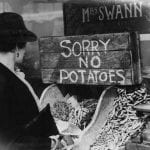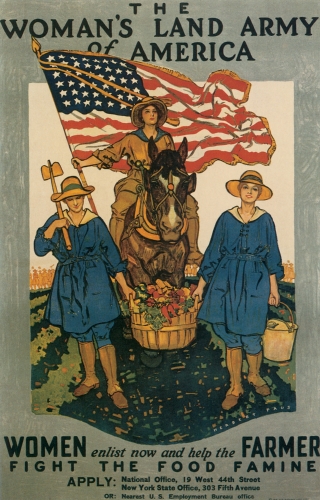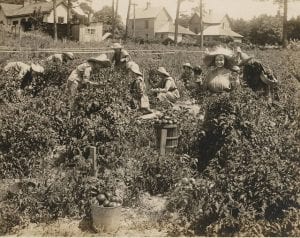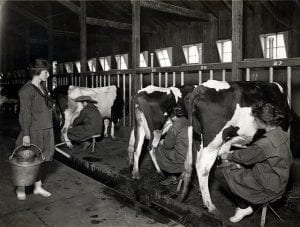The 50th anniversary of having females in the FFA is on the horizon (2019). The women in the FFA have proven they belong. The fight for female membership in the FFA, contrary to conventional wisdom, did not start in the 1960s but actually started in the 1930s with the delegates at the FFA Convention going behind closed doors to discuss the “Massachusetts Situation”. But that story will have to be reserved for a future Friday Footnote.
There was another time in the history of agriculture where women were challenged to prove themselves. This was during World War I and II.

When America entered World War I in April of 1917 many men, including farmers, marched off to war! Food immediately became an issue. During the winter of 1917, there were food riots in New York City and Philadelphia. Prices for food had quadrupled since the start of WWI. So what was the solution to the food production problem?
The government considered all types of political schemes including:
- Using convict labor on farms
- Not drafting farm workers
- Establishing an agricultural army comprised of men who could not pass the physical exams
- Shipping POWs to American and have them farm
- Having a compulsory national farm service program
- Excusing high school boys from school in the spring and have them work on farms instead (they did this in New York state – the Farm Cadet Program)
- Having women work in agriculture – Nah! Just Kidding. This was not considered by the government.
 Women, who had been marching for the right to vote (suffrage) were willing to put down their protest signs and pick up shovels and hoes and go work on farms. However, the government was not interested. So the women sprang into action. Six weeks after the U.S. Declaration of War, Suffragist groups in each state had appointed a Chairman of Agriculture (the ladies rejoiced about being called Chairmen of Potatoes). A myriad of other groups such as the Red Cross and the YWCA joined in the cause.
Women, who had been marching for the right to vote (suffrage) were willing to put down their protest signs and pick up shovels and hoes and go work on farms. However, the government was not interested. So the women sprang into action. Six weeks after the U.S. Declaration of War, Suffragist groups in each state had appointed a Chairman of Agriculture (the ladies rejoiced about being called Chairmen of Potatoes). A myriad of other groups such as the Red Cross and the YWCA joined in the cause.

In December of 1917, a “Continental Congress” of organizations (Women groups, defense groups, Farm Bureaus, Grange, etc. but not the government) met in New York City and established an organization known as the Women’s Land Army of America (WLAA). The Women’s Land Army was to be a group of women who volunteered to go work on farms during World War I (and World War II) to produce food for the war effort.
So was the government supportive of the WLAA? According to Weiss (2008, p. 73), “The official Washington attitude was that these women in khaki overalls and bloomers had not been asked to help in the fields, it was not their place; they were not needed, and they were a nuisance.” This is illustrated by Assistant Agriculture Secretary Clarence Ousley who wrote (Weiss, p. 74) that”…the Department does not care to take any leadership in the matter of urging women to do farm labor…”. He further complained that a “great number of organizations [are]…making a hysterical appeal for the use of the women on farms (p. 75). Ousley suggested that women could help by doing the laundry for the farmers and baking pies and cookies to take to the farm.
The USDA decided to get rid of the problem by shifting it to the Department of Labor. The Department of Labor did not want this hot potato. M. A. Coykendall of the Labor Department was quoted in the Philadelphia Evening Star that “…the reason women in the city should not leave to work on farms is that they are not physically fit to do real farm work” (Weiss, p. 90).
In spite of government resistance, the women were determined. Different state WLA units set up training camps to train the women how to do farm work. Training camps were set up in Libertyville, IL; Bedford, NY; Farmingdale, NY, Wellesley, MA, and in numerous other locations. After the women, who were referred to as Farmerettes, received training, they went out in groups of 6-8 to work on farms. They were paid the same wages as men.
 Many of the WLA recruits were college-age women, often from the elite women colleges of the east. And many were from the city. So the farmers had reservations – and the farmers’ wives were not wild about having young good looking women on the farm working with their husbands.
Many of the WLA recruits were college-age women, often from the elite women colleges of the east. And many were from the city. So the farmers had reservations – and the farmers’ wives were not wild about having young good looking women on the farm working with their husbands.
The women did all the farm jobs that men did. They plowed, milked cows, harvested fruits and vegetables, planted crops, operated machinery, pruned, weeded, packed fruits and vegetables, and worked with livestock. The most demand for the farmerettes was on the west coast and the fruit producing areas of the Northeastern states. The demand in the Midwest was low because of the nature of their agriculture; in the South, there were cultural beliefs to overcome.
At first, farmers were reluctant to employ the ladies, but quickly learned they were competent and dedicated. A journalist in California asked a farmerette if the strenuous labor might prove too hard and she might quit. Her response was “Would we quit? No, soldiers don’t (Weiss, p. 114).” The California Cultivator (June 8, 1918, p. 686) reported that some of the farmerettes “…have done far better than the ordinary hired man.”
To make a long story short, the women of the WLA proved they could do agricultural work. By the end of World War I, some 18,000 women had done their patriotic duty as Farmerettes. At the end of WWI, the WLA disbanded. However, the WLA was revived during World War II. This time the USDA was responsible for the WLA and worked with the Cooperative Extension Service in running the program. Between 1.5 and 3 million women served in the Women’s Land Army during World War II.
Since the women proved they were equal to men during WWI, the 19th amendment which granted the women the right to vote was ratified in 1920.
After WWII, the position of women in society shifted. In 1952, 10 million married women worked outside the home, three times the number of 1940. But it would be several more decades before the females were allowed to be in the FFA. I guess some folks are just slow learners.
If you want to learn more about the WLA there are excellent online articles at Smithsonian.com and KCET Television. I would also recommend Weiss, E. F. (2008). Fruits of Victory. Potomac Books, Washington, DC and Carpenter, Stephanie A. (2003). On the Farm Front. Northern Illinois Press, Dekalb. Weiss focuses on WWI while Carpenter looks at WWII. Cultivating Victory by Cecilia Gowdy-Wygant is also good. It looks at the WLA and Victory Gardens.
Teaching Ideas: If you are a high school teacher and would like to teach a lesson about the WLA (perhaps as part of a unit on Career Opportunities in Agriculture, or Agricultural History or even about including Females in the FFA) here are some ideas and resources.
- Have students do a Google Search for the Women’s Land Army. They could write a short paper about the WLA but focus on their own thoughts and reactions to the WLA.
- Have students search for posters and photographs about the WLA. Have them select 5-10 items and describe them. They could put them in a PowerPoint presentation and share with the class. Why did they select the images they did?
- Show videos about the WLA. The Australian WLA video is pretty good. Your students might like the recruitment film of two cows talking about the WLA of England. There are many others on YouTube (ranging from a few minutes to nearly an hour). Some are interviews of women who served in the Land Army.
- I have made presentations about the Women’s Land Army to the Chautauqua Institution in New York and to the Fountain Park Chautauqua in Indiana. A link to the PowerPoint I used is here. This is a very large file and takes some time to download. When I make presentations I often use electronic responders to engage the audience, so there are some slides in the presentation for this purpose. You might want to delete or edit them.
- You might also want to make your students aware of femalefarmerproject.com and farmher.com.
Remember the Friday Footnote Archives can be found at https://footnote.wordpress.ncsu.edu/.




